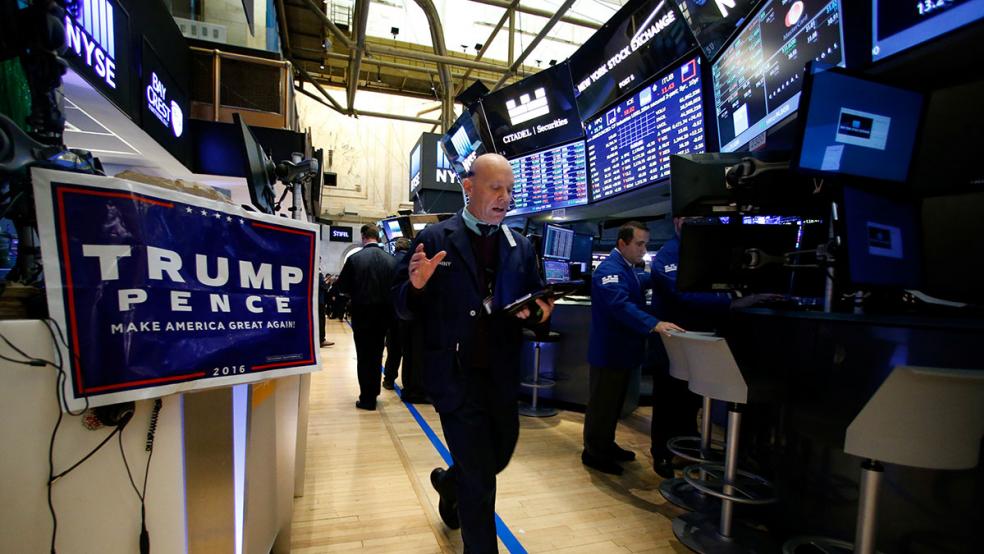It's fitting that the market response to President-elect Donald J. Trump — a brash nationalist with an "America first" credo — was a new record high for the Dow Jones Industrial Average to cap the best week on Wall Street in five years. But for many stock market sectors and pretty much every other asset class, last week was hellish. Treasury bonds were routed. Precious metals were pounded. Mega-cap tech and dividend-focused stocks were trounced. Emerging market assets and currencies were smashed.
While the Dow's surge is exciting, the turbulence overseas and in other areas of the market cannot be ignored. Nor can the cost of what is coming: The trillions in federal debt Trump is set to add as part of his fiscal stimulus plans and the possible risks of runaway inflation.
Related: 4 Reasons Trump’s Economic Policies Would Be a Disaster
Investors should remain cautious.
The market’s initial Tuesday night terror about an apparent Trump's win quickly gave way to aggressive buying as traders realized the president-elect’s tax cut, infrastructure spending and military buildup plans amount to a huge, if unfunded, fiscal stimulus totaling roughly $12 trillion over the next decade, according to the Committee for a Responsible Federal Budget.
Yet this late in the business cycle, and with trillions in idle cash sitting in the capital markets thanks to years of ultra-easy monetary stimulus from the Federal Reserve, such a stimulus could be highly inflationary.
Related: Here’s the Big Threat to the Stock Market’s Trump Surge
That's the warning coming from the bond market, with market-derived inflation expectations surging to early 2015 levels as long-term interest rates soar: The 30-year U.S. Treasury yield jumped to nearly three percent, up from a summertime low of 2.1 percent.
The team at Capital Economics is worried that Trump's plans to boost the economy risks lifting prices more than growth, especially if the new administration also mixes in a more aggressive renegotiation of trade policies enforced by tariffs in the hopes of bringing manufacturing back to the United States. Trade barriers, in all forms, essentially raise the costs of imports and thus overall prices.
Confirmation of higher inflation will not only force the Federal Reserve into a more aggressive rate hike path, it risks destabilizing the cheap credit conveyor that has lifted asset prices during this stimulus-fueled bull market. Remember, one of the main forces of demand for stocks has been corporate buybacks funded by cheap debt.
Related: Why Wall Street and Liberals Are ‘Bullish’ on Trump’s Stimulus Plans
The first sign of trouble is the sympathy selling hitting investment-grade corporate bonds and yield-sensitive stocks in areas like telecom, utilities, REITs and consumer staples. The iShares Investment Grade Corporate Bond ETF (LQD) fell more than 2 percent last week to return to levels not seen since June — wiping away a year's worth of dividends. The Utilities Select SPDR (XLU) is down more than 12 percent from its July highs.
Fear over these trade barriers has rattled foreign markets, too. China devalued its currency to the lowest level since breaking its dollar peg in 2010 in an effort to reinvigorate an overindebted, overinvested, export-dependant economy. This creates its own problem, as China's bad loan issues are exacerbated by the capital outflows encouraged by the currency weakening. Moreover, this is exactly the type of currency manipulation Trump wants the U.S. Treasury to crack down against. The iShares FTSE/Xinhua China 25 Index ETF (FXI) fell to test four-month lows on Friday, down more than 8 precent from its early October high.
It's even ugiler for Mexico, worried about not only a renegotiation or a scrapping of the North American Free Trade Agreement but Trump's call for it to pay for the construction of a border wall. The Mexican peso has lost more than 13 percent against the dollar while Mexican stocks have lost nearly 15 percent.
Related: Five Things Trump Wants to Do That Liberals Would Love
There is also the nagging problem of the narrowness of the stock market's rally since Election Day. Consider that on Friday there were just 220 net advancing issues on the NYSE compared to nearly 2,000 during Monday's "Hillary is saved!" rally. Or that just four Dow stocks — Goldman Sachs (GS), Caterpillar (CAT), JPMorgan (JPM) and Home Depot (HD) — were responsible for half the index's gain last week. Or that the performance divergence between the Dow and the tech-heavy Nasdaq (down on fears of a clampdown on skilled H-1B visas used heavily by Silicon Valley) was the largest since the financial crisis.
So while the Dow's gains were flashy and felt good for Trump and his supporters, they are masking deeper troubles. With the Federal Reserve's next rate hike likely just weeks away, the bond market turmoil is particular is likely to continue.







